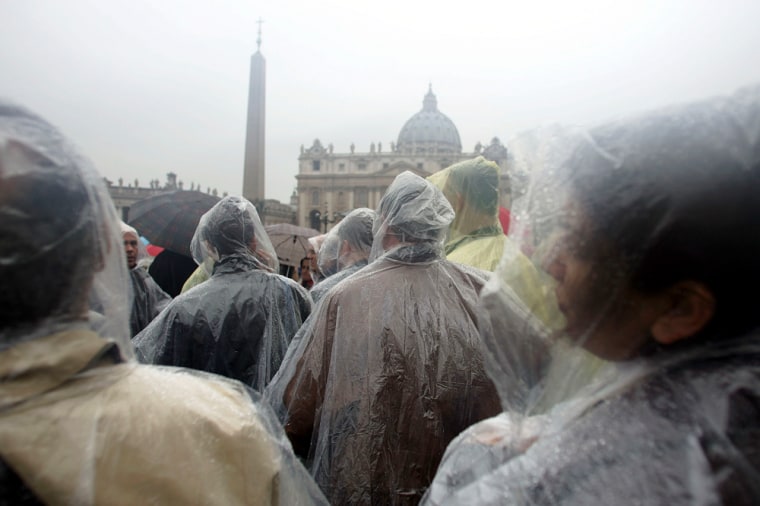The world’s Catholics looked to the College of Cardinals to begin the difficult task of choosing a worthy successor to John Paul II, while hundreds of thousands of weary pilgrims who flooded Rome for the pontiff’s funeral began their journeys home on Saturday.
Police cleared out St. Peter’s Square late Friday and blocked it with metal barricades, breaking up groups of Poles who stood in a circle in the drizzle, praying under their umbrellas.
“We hope that the new pope will continue the work that John Paul set up,” said Monica Barthicka, 23, a student from Warsaw.
Mateusz Rozycki, 25, an accountant also from John Paul’s homeland, drove to Rome in 20 hours for the elaborate funeral, one of the largest the world has ever witnessed.
“People in Poland, and maybe elsewhere, changed a little bit because of him. If some of those thoughts remain in our hearts for a little while, I will be satisfied,” Rozycki said.
Exodus from Rome
Pilgrims began a massive exodus, carrying backpacks, folded flags and rolled-up sleeping bags and headed for train stations or parking lots on the outskirts of the city. Rome officials estimated that most would be gone by the end of Saturday.
Police say some 4 million pilgrims traveled to Rome during the week to pay tribute to the pope. The turnout was comparable to the vast crowds that gathered to mourn Mohandas Gandhi of India, Mao Zedong of China and Ayatollah Ruhollah Khomeini of Iran.
John Paul’s funeral was also one of the most prestigious, drawing presidents, kings and religious leaders from all corners of the globe, including President Bush and his predecessors, Bill Clinton and George H.W. Bush.
Italy’s Minister of the Interior, Giuseppe Pisanu, said 1.4 million managed to file past the pope’s body during the four days he lay in state, after waiting in line for an average 13 hours. The numbers reported by Giuseppe Pisanu on a television talk show Friday were the most authoritative yet.
Pisanu said 21,000 people an hour passed through the bronze doors of St. Peter’s Basilica to see the pope’s remains, or 350 per minute. They were politely hustled through by black-suited ushers. At one point the line outside the church was three miles long, with people waiting as much as 24 hours before they reached the pope’s bier.
On Friday, 250,000 filled St. Peter’s Square for the funeral, Pisanu said. Others watched on 24 giant video screens set up around Rome, from university campuses to the Circus Maximus where ancient Romans held chariot races centuries before Christianity was born.
John Paul was laid to rest in the Vatican grottoes, the cramped, narrow passageways below the existing basilica and above the one built by the emperor Constantine. The grottoes hold the remains of popes of centuries past, including the tomb traditionally believed to be that of the apostle Peter, the first pope.
Papal spokesman Joaquin Navarro-Valls said the Vatican would announce in a few days when the grottoes would reopen to the public. Keeping them closed was a way of clearing the city of the huge throngs of pilgrims.
A tough act to follow
The College of Cardinals begins its conclave on April 18 to elect a successor, a papal election with new rules and new technologies. The number of cardinal electors under age 80 and therefore eligible to vote is 117, but one is too ill to attend.
Their challenge will be to find a successor who can measure up to John Paul, whose popularity was undimmed by his conservatism and who helped the church spread in Africa and Asia. He made unprecedented strides in opening contacts with other Christian denominations, Jews and Muslims. He made the first papal visit to a mosque — during a visit to Syria in 2001, and sought forgiveness for Jewish suffering at the hands of Catholics.
His efforts were evident at his funeral, attended by dignitaries from 138 countries. Their diversity reflected the extraordinary mix of faiths and cultures that John Paul courted during his 26-year papacy: Orthodox bishops in long black robes, Jews in yarmulkes, Arabs in checkered headscarves, Central Asians in lambskin caps and Western political leaders in dark suits.
Across Africa, Asia and the Americas, church bells tolled and millions of people gathered in open fields, sports stadiums, town squares and cathedrals to watch the funeral on giant screens. Millions more mourned privately at home.
Live footage was beamed across the Middle East by the pan-Arab television station al-Jazeera, and Muslims, Buddhists, Hindus and Sikhs joined Roman Catholics in church services and prayers throughout Asia to honor a pope who reached out to other faiths.
In a gesture the pope would certainly have applauded, Israeli President Moshe Katsav said he shook hands and chatted briefly with the leaders of his country’s archenemies, Syria and Iran. The Israeli president said his handshake with Syrian President Bashar Assad came at the point in the service when members of the congregation “exchange the peace.”
However, upon his return to Iran, Iranian President Mohammad Khatami strongly denied the incident took place.
“This claim is like other baseless claims made by the Zionist media in the past,” Khatami told the official IRNA news agency.
